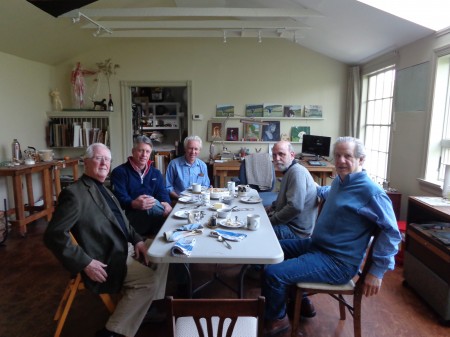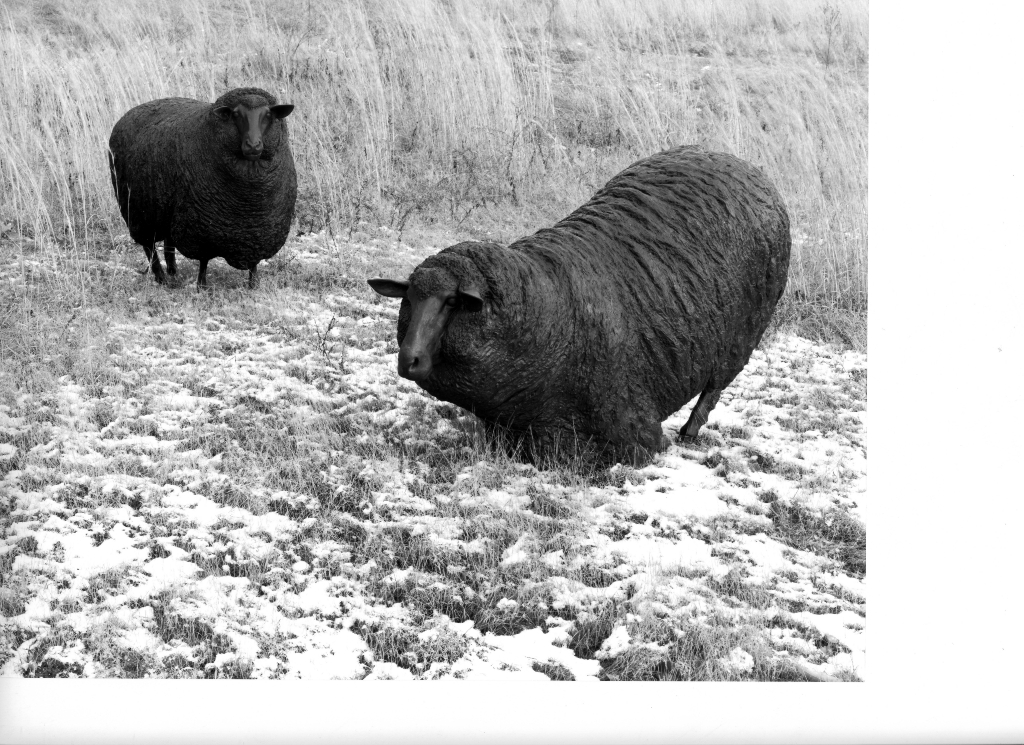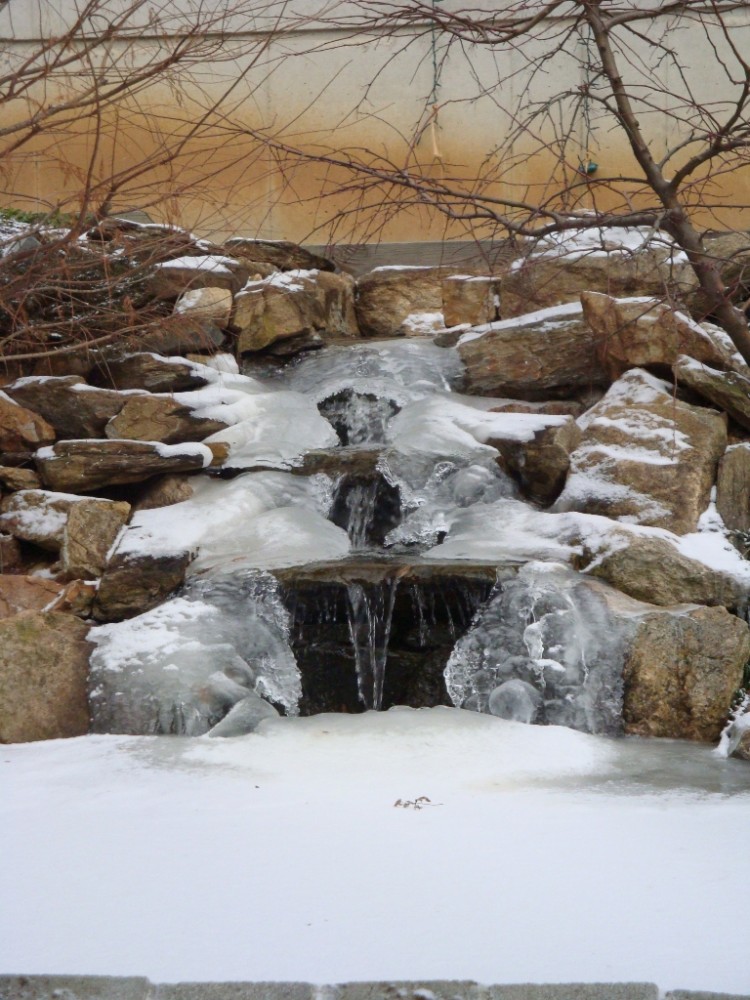We are in the middle of a cold snap with temperatures below zero in the mornings. Prior to 2014, in cold weather Clayton would have to turn the heaters on full to get the studio up to 50 by the afternoon, and he had to heat the clay separately because it isn’t malleable enough at 50 degrees. Even then there were some days it was just to cold to work in his studio. Now it is a different story. Clayton totally rebuilt his studio in the spring of 2013, adding niceties such as insulation and sealed seams on the floor and walls. His studio is now balmy (in the 60’s) even at our frigid temperatures, and he can sculpt or paint as soon as the light is appropriate. He can even invite artist friends for breakfast!
 Starr Cummin Bright
Starr Cummin Bright
January 26, 2015
 Sculptures in the garden, even in winter, prove to be eye-catching. Recently I looked at the sheep and thought, “With all that wool, you must be warm despite the weather!” One look at those skinny legs and it is readily apparent just how thick their fleece can become. Indeed, Clayton depicted in his sculpture how the fleece can be so thick that it actually parts when a sheep turns its head. As I stand looking at them, I feel sense that these sheep are watching to see how close I am going to get before they leave the scene. Nothing like realistic art.
Sculptures in the garden, even in winter, prove to be eye-catching. Recently I looked at the sheep and thought, “With all that wool, you must be warm despite the weather!” One look at those skinny legs and it is readily apparent just how thick their fleece can become. Indeed, Clayton depicted in his sculpture how the fleece can be so thick that it actually parts when a sheep turns its head. As I stand looking at them, I feel sense that these sheep are watching to see how close I am going to get before they leave the scene. Nothing like realistic art.
January 4, 2015
 Happy New Year to All!
Happy New Year to All!
Clayton is currently working on proposals, so instead of perusing his studio, I am standing at the kitchen counter observing the Japanese garden he designed. I am constantly amazed at the scope of Clayton’s planning; even in “bleak mid-winter,” this garden is alive and vibrant. Espaliered wisteria branches, pruned a month ago, decorate the broad expanse of the back wall which protects this garden from the sound and sight of cars zooming by on the road outside. In the middle of the wall hangs a bird feeder where at the moment a Red-Bellied Woodpecker, a Starling, and three House Sparrows are all feeding. Waiting on the wisteria branches are a Tufted Titmouse, a Cardinal and a Black-Capped Chickadee. Three Blue Jays and a pair of Mourning Doves are cleaning up the unopened seeds which have fallen to the ground. Below, a Song Sparrow drinks from a small pool midway down the waterfall, while five other Sparrows are bathing to the right near the shallow “rapids” of this same re-circulating water element. Behind these birds is ground-hugging green and white ivy and behind this, a grove of seven pruned black gum trees and waist high variegated bamboo, the latter still sporting its green and yellow leaves. On the far left side of this scene near the moon gate leading out to the road, a climbing rose still clings to its green leaves, reflecting the micro-environment created in the small enclosed space. Green pachysandra leads my eye back to the wintergreen with its red berries directly in front of the kitchen window. What a joyous scene to behold while drinking hot tea in a warm kitchen.
December 24, 2014
 When Clayton travels (usually by car) he thinks about the big picture of his work and connecting to people who would be interested. Coming home with brilliant ideas is great, but then one has to work to implement them. We are very pleased with this web site, but no one knows about it unless we spread the news. So we have set up an e-news letter, which will come out three times a year along with a fourth hard copy newsletter each fall, in case people aren’t on line or we don’t have their email. Please pass on the web site and our emails to those who enjoy Natural Realism, the core of Clayton’s art. Word of mouth is a powerful tool.
When Clayton travels (usually by car) he thinks about the big picture of his work and connecting to people who would be interested. Coming home with brilliant ideas is great, but then one has to work to implement them. We are very pleased with this web site, but no one knows about it unless we spread the news. So we have set up an e-news letter, which will come out three times a year along with a fourth hard copy newsletter each fall, in case people aren’t on line or we don’t have their email. Please pass on the web site and our emails to those who enjoy Natural Realism, the core of Clayton’s art. Word of mouth is a powerful tool.
December 3, 2014
We have shifted from the autumnal spectrum of color to the muted hues of winter. Yet there is a reminder of this past fall. Looking at recent paintings of Claytons one sees the panorama of leaves, the last fruits, bright yellow gourds and enormous orange pumpkins. Clayton’s paintings picked up these colors, transient though they were. He has often spoken of his sculptures as being a snapshot of a certain moment in his model’s life, albeit a moment that reflects the animal or person’s personality. So too with his paintings, Clayton captures that moment observed and turns it into a moment preserved on canvas, turning the scene into a painting for you, the viewer, to experience as well.
November 23, 2014
[envira-gallery id=”894″]
Clayton is currently in Thomasville Georgia at the 19th Plantation Wildlife Arts Festival. He has been attending this large sporting and wildlife art show since its inception, and was the featured artist in 1999. Although initially Clayton only displayed his sculptures, as he has painted more and more of the wildlife around him he now includes a number of paintings each time he travels to this event.
October 31, 2014
Clayton works on a variety of paintings every day, in part due to the different lighting of landscapes and in part because one can only apply so much oil paint before it needs to dry. One of his current studies is a landscape depicting the warmth of early morning light on a frosty morning. As he paints Clayton writes down what he has done: the colors and how much of each he used in the hillside and the woods; the difference from fore to background; the layers he has used to achieve a color harmony in the painting; what he has done to depict the effects of light in the scene. In this specific painting there is a horse with a blanket in the foreground. He noted that he used ultramarine of different thicknesses to portray the blue blanket and its folds, and then added cerulean blue where the blanket was lit by the sun. By keeping a log, Clayton can later compare his studies to see what has worked best to depict the desired effect.
October 14, 2014
Clayton’s art reflects the environment in which he works and lives. Now mid- October, Clayton has been gathering pears and apples form the orchard he planted ten years ago. The vegetable garden is winding down, though still producing some above ground fruits and vegetables. Clayton picked the last Warren pear and brought it along with a couple of Sungold tomatoes into the studio to paint instead of eat. Since his pears aren’t sprayed with any chemicals, sometimes insects will burrow in, leaving indentations as the pear grows around their entry point. Organic growing can make for interesting looking fruit, and this pear has character. The two orange cherry tomatoes offer an eye catching contrast in color to the green Warren pear.
September 18, 2014
Clayton recently finished sculpting a turkey vulture with a deer. This is a familiar sight where we live: deer are hit by cars and their carcasses are cleaned off the road by vultures. This was technically a challenging piece for Clayton, but he was satisfied by the end. (“It is not done until it is done,” he always says.) Clayton took the rubber mold (negative – see the Process section on this web site) to the foundry,waited a few hours while they created the wax, and was able to rework the wax that same day. Quick work at New Art Foundry – thank you! It will be in bronze by the end of October.
September 5, 2014

Always open to different ideas and approaches, Clayton is about to head west to Wyoming to the Susan Kathleen Black Foundation Workshop of Plein Air Painting. The program suggests bringing a whole list of painting paraphernalia. One piece of equipment not mentioned on the list, but which is a staple for Clayton when plein air painting, is his pochade box. A pochade box contains the easel in the interior of the open lid and the palette fits in the interior of the bottom portion of the box.
Clayton designed his first pochade box over sixteen years ago when he was painting street scenes in Paris. The lap held version he is using now is ultra-light – all of 2 lbs, 4 oz., and created it to hold a specific canvas – Centurion oil primed linen – and the palette section to fit Richardson’s Grey Matters 9 by 12 inch palette paper, which is affixed using a spray adhesive. This is a lap held pochade, not one set on a tripod. It is secured by a Velcro strap to the leg of the painter. There are true advantages to this system. When Clayton is in a boat which can rock back and forth with wake, he and the easel and palette rock together, so he is not trying to reach up to a painting that may move independently. In addition there is no need to carry a tripod around as well. Clayton can carry his pochade box, a collapsible stool and a container of mineral spirits and a small trash jar in one trip.
This summer when Clayton was painting while sitting anchored in a small motorboat at 5:30 a.m., a lobsterman, who happened to be a good friend, passed by. A cursory glance made him think to himself, “Now I have seen everything! Some guy out on a boat with his computer.” So slim and portable, that’s the impression it gave. Lots of laughs followed later when Rick found out what what it really was.
August 18, 2014
One of the aspects of island life is that there are so only so many caretakers and handy men, and the amount of work that needs to be accomplished during the summer can be monumental. Lining up a project is no guarantee that is will get started on time because there are always emergencies and situations with priority.
Clayton knew he had to replace the roof on his studio this summer. Shingles were flying off at an alarming rate and there were leaks. Once Clayton arrived and spoke with the caretaker who was going to replace the roof, the shingles were ordered. To keep the interruption of his work inside the studio to a minimum, Clayton decided to work alongside the two men removing the old shingles and applying the tar paper to keep the rain flowing off until the new shingles arrived. Unfortunately, the day the shingles were to arrive the cable on the barge broke, so the delivery was put off for a week. During that time the sun beat down and the tar paper on the roof was old enough that it shrank and became ineffectual. So there was a trip to procure replacement tar paper and Clayton reapplied it and waited for the delivery of new shingles. Someplace along the way there was an emergency which took the men off the job, and then another batch of bad weather. It has been three weeks, and the roofing job is almost done with only the capping remaining. Luckily the work proceeded far enough that Clayton is happily back to work inside instead of on top of his studio.
July 25, 2014
Clayton is rising at 4:15 am on clear mornings in order to bicycle down to the dock, row out to his skiff and motor to a spot where a multicolored granite rock caught his eye. He particularly appreciates the way the early morning sun accentuates the brilliant yellow, orange and green of the rock, which contrast sharply with the dark crevasses in the shadows. At a bit off high tide, on a typical windless morning, the placid sea provides a balance to the rough textured rock. Cormorants and gulls regularly settle on this perch above the fish filled ocean and they donate a white cap of guano to complete the spectrum from dark to white.
